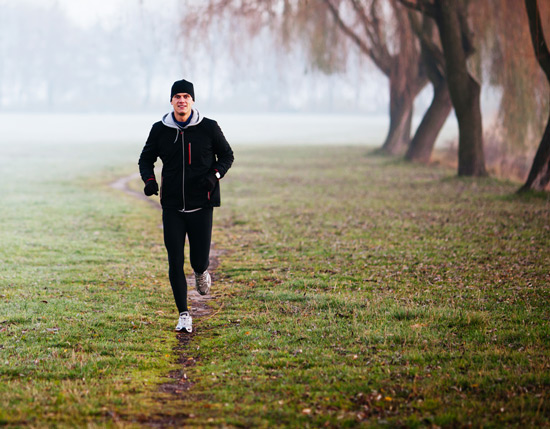Despite November starting unseasonably warm, it won’t last. Thankfully, our cold-weather tips will keep you training all winter.
Gyms serve a purpose, providing a cosy backdrop to your winter training. But races don’t take place behind closed doors. Mother Nature is the host, and if you’ve any chance of challenging her – let alone beating her – it’s essential you get outside and rack up the miles. But as the NHS has shown you’ve an 80% greater chance of being stricken by a cold in the winter months, what’s the best way to remain healthy while boosting stamina and strength? Good question…
Dress appropriately. This means layering, which is especially important on the bike when you had the added temperature drop of windchill (that can make the environment feel up to 5°C colder depending on how fast you’re riding). On the bike, a close-fitting long-sleeved base layer will not only insulate but also transfer sweat away from your body to maintain optimum core temperature. A mid-layer, like a short-sleeved cycle shirt, is next followed by a waterproof or windproof jacket. Gloves, bib longs and maybe booties and a Buff complete the look. On the run, leggings will prevent cold-related muscular strains, while a base layer and lightweight jacket’s the preferred combo of many.
Head off-road. If you’re a road cyclist, try a spot of mountain biking. Not only does this eradicate the potential dangers of icy roads, but the slower speeds mean windchill’s also not an issue, though not at the expense of a taxing workout.
Hit the fruit and veg. Your immune system’s stretched more over the winter and it needs your support. The ORAC scale (Oxygen Radical Absorbance Capacity) measures the antioxidant capacity of foods. Spices like cloves and cinnamon register highly – something to bear in mind when making mulled wine – as do blueberries, almonds and broccoli. In short, if it’s colourful, there’s a good chance it’ll be good for you. Raw is best; when cooking, steaming’s preferred over boiling.
Remember to drink. Athletes often forget to hydrate when exercising in the cold, but your sweat rate isn’t that much different than when training in more temperate conditions, so ensure you drink during the bike and run. Around 350ml-500ml of liquid each hour is fine. If a cold drink’s not tempting, you can go for a drink like Skratch Labs Apple & Cinnamon, which can be taken hot. There are also water bottles on the market that keep your drink warm.
A good night’s sleep. Recent research has shown that you’re nearly five times more likely to suffer a cold if you sleep less than 5hrs a night compared to seven or eight. Though tempting, refrain from turning the heating on at night. It dries out the air, causing restlessness and a bad night’s sleep. Blankets are also recommended over a whopping great duvet. The latter might feel softer than duck feathers but it doesn’t regulate temperature like blankets. (This can become even more important when sleeping with a partner who clearly has a different internal thermostat than you!)
James Witts is a writer & editor specialising in endurance sport, health & fitness, outdoor adventure and sports science.











